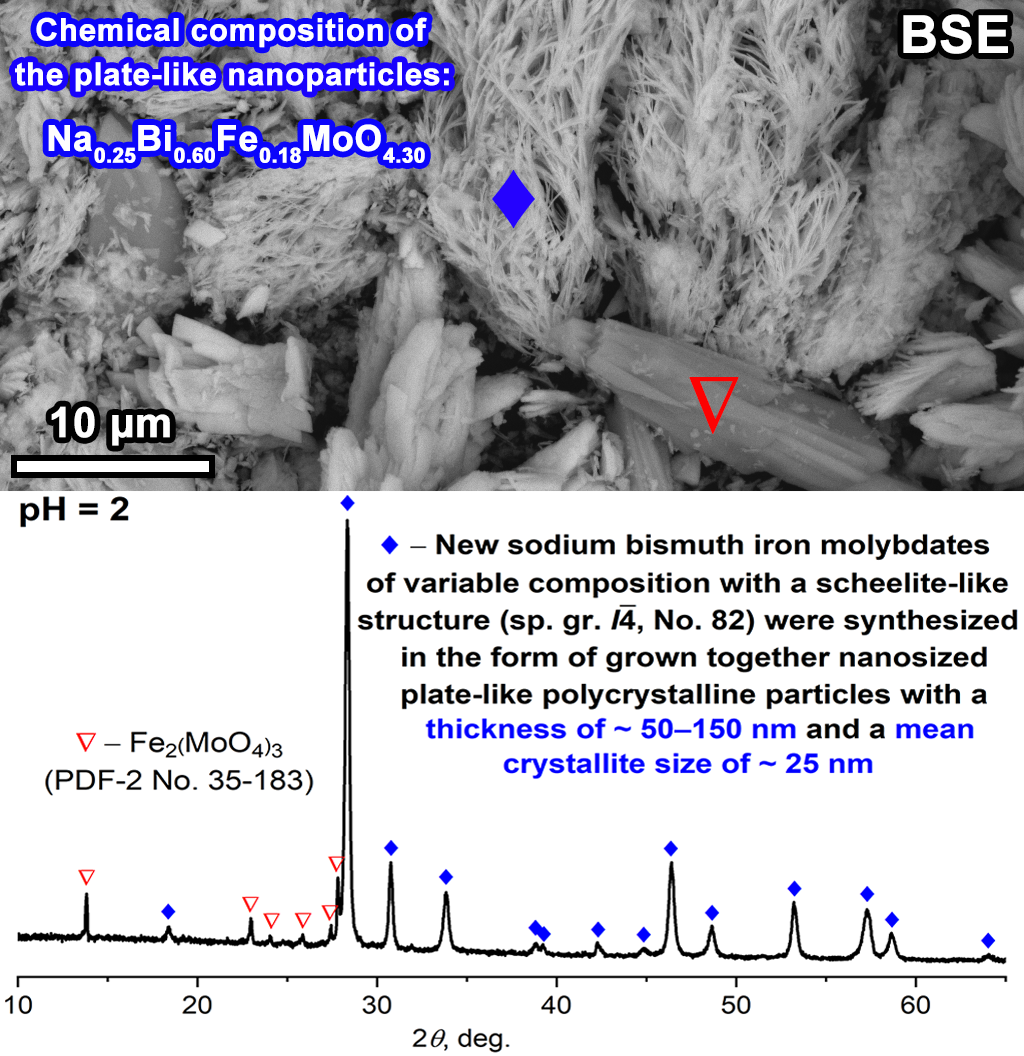Nanosystems: Phys. Chem. Math., 2025, 16 (2), 235–242.
Phase formation in the Na2O–Bi2O3–Fe2O3–MoO3–(H2O) system
Makariy S. Lomakin – Ioffe Institute, St. Petersburg; Branch of Petersburg Nuclear Physics Institute named by B.P. Konstantinov of National Research Centre “Kurchatov Institute” – Institute of Silicate Chemistry, St. Petersburg, Russia; lomakinmakariy@gmail.com
DOI 10.17586/2220-8054-2025-16-2-235-242
ABSTRACT The effect of the hydrothermal fluid pH on the chemical and phase composition, as well as the size parameters and morphology of crystallites and particles of hydrothermal synthesis products formed in the Na2O–Bi2O3–Fe2O3–MoO3 system at T = 170 °C and P < 7 MPa has been studied. It has been established that in the acidic pH region, the bulk chemical composition of the hydrothermal synthesis products is depleted relative to the nominal composition specified for the synthesis in iron oxide, while in the alkaline pH region, it is depleted in molybdenum oxide and, to a lesser extent, in bismuth oxide, while the best correspondence between the nominal and bulk composition observed at pH = 2. It is shown that in the pH range from 2 to 6 new compounds of variable composition (Na0.19−0.47Bi0.42−0.85Fe0.14−0.31MoOy) with a scheelite-like structure (sp. gr. I¯4, No. 82) are formed, which have not been previously described in the scientific literature. These compounds with the smallest mean crystallite size (~25 nm) were obtained at pH = 2, and it was shown that under these conditions polycrystalline plate-like particles (thickness (h) ~50–150 nm) are formed, often having a curved shape, which grow together to form agglomerates with a “flower-like” morphology. It was found that fluorite-type solid solutions (Bi3.65−4.30Fe0.37−0.45MoOz) are formed in alkaline media (isostructured to the oxide δ-Bi2O3 (sp. gr. Fm¯3m, No. 225)).
KEYWORDS hydrothermal synthesis, sodium bismuth iron molybdate, scheelite-like structure, nanocrystals, fluorite-type solid solutions.
ACKNOWLEDGEMENTS XRD, SEM and EDXMA studies were performed employing the equipment of the Engineering Center of the St. Petersburg State Institute of Technology (Technical University). The author expresses his deep gratitude to Corr. Mem. RAS Victor Vladimirovich Gusarov for valuable comments and advice on improving the quality of the manuscript. The work was financially supported by the Russian Science Foundation (Project No. 24-13-00445).
FOR CITATION Lomakin M.S. Phase formation in the Na2O–Bi2O3–Fe2O3–MoO3–(H2O) system. Nanosystems: Phys. Chem. Math., 2025, 16 (2), 235–242.
[In Russian] М.С. Ломакин
Фазообразование в системе Na2O–Bi2O3–Fe2O3–MoO3–(H2O)
УДК 54.057:542.468:661.887:661.877:661.872.2
АННОТАЦИЯ Исследовано влияние pH гидротермального флюида на химический и фазовый состав, а также размерные параметры и морфологию кристаллитов и частиц продуктов гидротермального синтеза, формирующихся в системе Na2O–Bi2O3–Fe2O3–MoO3 при T = 200 °C и P ~ 7 MPa. Установлено, что в области кислых pH валовый химический состав продуктов гидротермального синтеза обедняется относительно заложенного по синтезу (номинального) состава по оксиду железа, в то время как в области щелочных pH ‒ по оксиду молибдена и, в меньшей степени, по оксиду висмута, при этом наилучшее соответствие между номинальным и валовым составом наблюдается при pH = 2. Показано, что в диапазоне pH от 2 до 6 формируются новые соединения переменного состава (Na0.19−0.47Bi0.42−0.85Fe0.14−0.31MoOy) с шеелитоподобной структурой (пр. гр. I4 ̅, No. 82), ранее в научной литературе не описанные. Указанные соединения с наименьшими средними размерами кристаллитов (~ 25 нм) были получены при pH = 2, и было показано, что при этих условиях формируются поликристаллические пластинчатые частицы (толщина (h) ~ 50 ‒ 150 нм), нередко имеющие изогнутую форму, которые срастаются друг с другом с образованием агломератов с «цветок-подобной» морфологией. Установлено, что в щелочных средах формируются твердые растворы (Bi3.65−4.30Fe0.37−0.45MoOz) со структурой флюорита (изоструктурны оксиду δ-Bi2O3 (пр. гр. Fm3 ̅m, No. 225)).
КЛЮЧЕВЫЕ СЛОВА Гидротермальный синтез, молибдат натрия висмута железа, шеелитоподобная структура, нанокристаллы, твердые растворы со структурой флюорита



